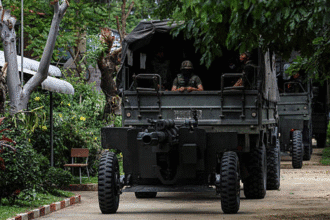The current Pakistan flood crisis has displaced over 200,000 individuals, and it has destroyed various districts in Punjab province. Bursting rivers–most notably the Sutlej, Ravi, and Chenab–have caused mass evacuations.
Boats have been used to ferry trapped citizens with the assistance of local rescue teams and the army. This move is taken after India announced that it would discharge surplus water in the upstream dams, which will only worsen the situation of floods in downstream Pakistan.
The situation is still critical with emergency operations going on in high-risk urban locations such as Lahore, Sialkot, and Gujarat.
Why Has Punjab Been Severely Affected?
The geography of Punjab predisposes it to floods of the rivers. As India opens its major dams, the low areas of Pakistan are becoming flooded by rivers.
Sialkot has recorded its highest rainfall in almost 50 years in the past 24 hours, according to reports by the meteorologists. This has drowned big portions, thereby isolating homes, roads, and vital services. Here is the link to our article on the Bengaluru Flood Crisis.
What Are the Authorities Doing?
The National Disaster Management Authority (NDMA) has issued warnings to the citizens to avoid rivers and drains. Prime Minister Shehbaz Sharif affirmed that the federal government is in total support of provincial efforts, especially in flood-prone cities.
In the meantime, the military has been sent in to do evacuations and relief operations. They have already rescued more than 32,000 people, and more are being moved to government shelters temporarily.
Why Are Other Residents not evacuating?
Even after the warnings, not all the villagers are willing to abandon their homes. To them, the floodwaters do not only translate to loss of livelihood but also shelter.
An example of this is Kasur district, where many of its residents are opting to remain to guard livestock and stock food. In a village of 3,000 residents, in which almost half refuse to evacuate, almost half are doing so.
Since more than 40 percent of Pakistani citizens live below the poverty threshold, most families are afraid to start over without resources. Here is the link to our article on Texas Flood Warnings.
What Is the Relationship of the Dam Releases in India?
The flooding crisis in Pakistan deteriorated when India offered water releases through its dams, overflowing as a result of heavy monsoon rains.
In spite of the fact that the level of communication between India and Pakistan is low, the warning signal has been taken into consideration by the Pakistani authorities.
Traditionally, cross-border rivers have presented difficulties in controlling the cross-border rivers in the two countries, particularly when it comes to the monsoon.
What Effect Do Monsoon Rains have on other Areas?
The monsoon has devastated the region. On the Indian side, a fatal landslide at the Vaishno Devi shrine in Jammu and Kashmir has recently killed at least 30 people.
This shows how climate volatility has swept South Asia and which is increasingly experiencing weather extremes annually.
Final Thoughts
The crisis of the Pakistan flood is an alert that more disaster preparedness, regional coordination, and climate resilience are needed. Early evacuations and communal help are important when the waters are high to ensure the amount of damage is reduced. Survival is now, however, a matter of immediate assistance and long-term reconstruction to many on the ground.








